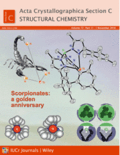
ACTA CRYSTALLOGRAPHICA SECTION C-STRUCTURAL CHEMISTRY
Scope & Guideline
Unveiling Innovations in Crystallography
Introduction
Aims and Scopes
- Crystal Structure Determination:
The journal emphasizes the detailed determination of crystal structures using techniques such as X-ray diffraction, electron diffraction, and powder diffraction, providing critical insights into molecular arrangements. - Supramolecular Chemistry:
Research on supramolecular interactions and assemblies is a core area, focusing on how non-covalent interactions lead to complex architectures and properties in materials. - Material Science Applications:
The journal covers the structural characterization of materials with potential applications in electronics, catalysis, and drug design, showcasing the relevance of crystallography in applied sciences. - Computational Chemistry and Modeling:
A significant focus is placed on computational approaches, including density functional theory (DFT) and molecular dynamics simulations, to predict and analyze structural and electronic properties. - Biological and Pharmaceutical Chemistry:
The journal publishes studies that explore the crystal structures of biologically active compounds, including drug candidates and their interactions, highlighting the importance of crystallography in medicinal chemistry.
Trending and Emerging
- MicroED and 3D Electron Diffraction:
The rise of micro electron diffraction (MicroED) techniques is evident, showcasing a trend towards utilizing advanced electron microscopy for structure determination of small crystals, including biological macromolecules. - Intermolecular Interactions and Non-Covalent Bonds:
There is an increasing focus on studying various types of non-covalent interactions, such as hydrogen bonding, halogen bonding, and π-π stacking, emphasizing their roles in stabilizing crystal structures and influencing properties. - Advanced Materials Characterization:
The journal is witnessing a surge in research related to the characterization of novel materials, including metal-organic frameworks (MOFs), coordination polymers, and organic-inorganic hybrids, reflecting a trend towards materials science. - Integration of Theoretical and Experimental Approaches:
A notable trend is the integration of theoretical modeling with experimental crystallography, enhancing the understanding of structure-property relationships and enabling predictions of crystal behavior. - Sustainability and Green Chemistry:
Emerging themes include the synthesis and characterization of materials with sustainable applications, such as catalysis and drug design, aligning with the global focus on environmentally friendly practices.
Declining or Waning
- Classic Coordination Chemistry:
There has been a noticeable reduction in papers focusing solely on classical coordination compounds and their structures, as research increasingly shifts towards more complex and multifunctional materials. - Traditional Organic Crystallography:
Studies that primarily report on organic crystal structures without significant new insights or applications are becoming less frequent, as the field evolves towards more interdisciplinary approaches. - Static Crystal Structures:
Research centered around static crystal structures, without considerations for dynamic behavior or interactions, is waning, possibly due to the growing interest in understanding structural dynamics and flexibility.
Similar Journals
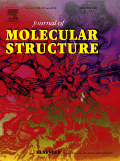
Journal of Molecular Structure
Illuminating the complexities of molecular behavior.Journal of Molecular Structure is a premier publication in the field of chemistry, offering a platform for innovative research that spans analytical, inorganic, organic chemistry, and spectroscopy. Published by Elsevier in the Netherlands, this journal is committed to advancing the understanding of molecular architecture and behavior through high-quality, peer-reviewed articles. With its impressive impact factor and a notable Scopus ranking placing it in the top quartiles among its peers, it serves as an essential resource for researchers, professionals, and students alike. The journal's open access options promote the dissemination of knowledge, ensuring that groundbreaking discoveries reach a broad audience. Established in 1967 and projected to continue through 2025, the Journal of Molecular Structure is vital for anyone engaged in the study of molecular interactions and structural analysis.
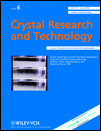
CRYSTAL RESEARCH AND TECHNOLOGY
Advancing the Frontiers of CrystallographyCRYSTAL RESEARCH AND TECHNOLOGY, published by WILEY-V C H VERLAG GMBH, is a distinguished journal in the fields of Chemistry, Condensed Matter Physics, and Materials Science, with over five decades of continuous publication from 1966 to 2024. With its ISSN 0232-1300 and E-ISSN 1521-4079, the journal serves as a crucial platform for disseminating significant research findings, theoretical advances, and technological innovations related to crystal growth, structure, and properties. Holding a Category Quartile ranking of Q3 in the 2023 assessments across its disciplines, CRYSTAL RESEARCH AND TECHNOLOGY is recognized for its contribution to the scientific community, making it an essential resource for researchers, professionals, and students alike. While this journal is not open access, its robust publishing framework ensures that high-quality peer-reviewed articles remain accessible to a global audience. The importance of this journal lies in its commitment to advancing knowledge and fostering collaborations in crystallography and related fields.

CRYSTALLOGRAPHY REPORTS
Championing Excellence in Scientific ReportingCRYSTALLOGRAPHY REPORTS (ISSN: 1063-7745, E-ISSN: 1562-689X), published by PLEIADES PUBLISHING INC, is a pivotal journal in the fields of chemistry, condensed matter physics, and materials science. Established in 1996 and continuing through to 2024, it serves as a vital resource for researchers and professionals seeking to disseminate and engage with contemporary advancements in crystallography. While currently not classified as open access, the journal's rigorous peer-review process ensures the publication of high-quality research, making it a respected entity within the academic community. With a categorization in the Q4 quartile for its respective fields and notable Scopus rankings, CRYSTALLOGRAPHY REPORTS is committed to fostering an understanding of crystallographic techniques and their application across scientific disciplines. This journal is essential for those looking to stay abreast of the latest findings and methodologies in crystallography, providing a platform for impactful discussions and collaborations.

Acta Crystallographica Section B-Structural Science Crystal Engineering and Materials
Driving excellence in structural science and engineering solutions.Acta Crystallographica Section B: Structural Science, Crystal Engineering and Materials, published by the International Union of Crystallography, stands as a pivotal resource for researchers and professionals in the fields of materials science, crystal engineering, and structural biology. With an e-ISSN of 2052-5206, this journal is recognized for its contributions to advancing knowledge on the structural aspects of materials, drawing significant interest from the Q2 category in several disciplines, including Atomic and Molecular Physics and Materials Chemistry. As the field evolves through innovative research approaches and methodologies, the journal actively covers developments within the scope of materials synthesis, characterization, and application in various sectors including medicine and electronics. Though not an open-access journal, it is entangled in the scientific discourse, ensuring that key studies are accessible to academic institutions and professionals globally. With a commitment to excellence, its impact across multiple quartile rankings signifies its influence and importance for scholars eager to contribute to cutting-edge research.
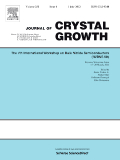
JOURNAL OF CRYSTAL GROWTH
Exploring the Intricacies of Crystal GrowthJOURNAL OF CRYSTAL GROWTH, published by Elsevier, stands as a vital platform in the realm of condensed matter physics, inorganic chemistry, and materials chemistry. With its inception dating back to 1967 and a promising convergence continuing through 2024, this journal encompasses the latest research and advancements in crystal growth phenomena. Although it does not currently offer open access options, its rigorous peer-review process ensures high-quality scholarly contributions that are essential for researchers, professionals, and students alike. The journal's solid standing is reflected in its Scopus rankings, with placements in the third and second quartiles across relevant fields and notable percentiles. Operating from the heart of the Netherlands, JOURNAL OF CRYSTAL GROWTH not only fosters academic dialogue but also enhances the understanding of crystallization processes crucial for materials engineering and applied sciences, making it an indispensable resource for anyone dedicated to exploring the intricacies of crystal growth.

JOURNAL OF MOLECULAR MODELING
Pioneering Research in Molecular Modeling and BeyondJOURNAL OF MOLECULAR MODELING, published by Springer, is a pivotal resource for researchers and professionals in the fields of chemistry, computer science, and molecular sciences. The journal's ISSN is 1610-2940, with an E-ISSN of 0948-5023, reflecting its commitment to disseminating cutting-edge research from 1996 to 2024. Although the journal does not operate under an Open Access model, it remains an invaluable platform for the publication of innovative studies related to computational methods, theoretical chemistry, and molecular simulations. With a notable categorization across multiple quartiles—including Q4 in Catalysis and Q3 in Computational Theory and Mathematics—the journal holds a distinct rank in Scopus, highlighting its influence and contribution to the discipline. The importance of this journal lies in its ability to bridge the gap between theoretical understanding and practical applications, making it essential reading for students and scholars seeking to advance their knowledge and research in molecular modeling.

Results in Chemistry
Advancing the Frontiers of Chemical ResearchResults in Chemistry is a prominent journal published by Elsevier, dedicated to fostering innovation and disseminating cutting-edge research in the field of chemistry. With an ISSN of 2211-7156, this open-access journal has been committed to making scientific knowledge widely available since 2019, aligning with the global trend towards accessibility in research. Based in the Netherlands, it features interdisciplinary studies that span the breadth of general chemistry, contributing significantly to the academic dialogue within the scientific community. Despite currently holding a Q3 ranking in the miscellaneous category of chemistry and occupying the 228th position out of 408 in Scopus rankings, the journal is poised for growth, aiming to enhance its impact and visibility. Researchers, professionals, and students alike will find invaluable resources and insights within its pages, making Results in Chemistry an essential platform for those looking to stay abreast of advancements and trends in chemistry research up to the year 2024.

JOURNAL OF CHEMICAL CRYSTALLOGRAPHY
Unlocking the secrets of chemical crystallography since 1994.Welcome to the Journal of Chemical Crystallography, a prominent publication dedicated to the advancement of knowledge in the fields of chemical crystallography, general chemistry, and condensed matter physics. Published by Springer/Plenum Publishers, this journal provides a critical platform for researchers, professionals, and students to disseminate and access innovative research findings and methodologies from 1994 to 2024. With an ISSN of 1074-1542 and E-ISSN 1572-8854, the journal currently holds a Q4 quartile ranking in both Chemistry and Condensed Matter Physics, reflecting its broadening scope and niche significance within the scientific community. While it operates under a traditional access model, it endeavors to promote high-quality research that advances theoretical and practical aspects of crystallography, making it an essential resource for those involved in these dynamic disciplines. Join us as we explore the intricate world of chemical structures and their properties, bridging gaps between chemistry and physics.
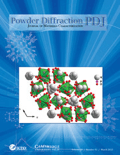
POWDER DIFFRACTION
Illuminating the Path of Crystalline CharacterizationPOWDER DIFFRACTION, published by Cambridge University Press, is a pivotal journal focused on the evolving field of powder diffraction, which is crucial for researchers in condensed matter physics, materials science, and radiation studies. Established in 1986, this journal emphasizes the latest methodological advancements and applications in powder diffraction techniques, making it a comprehensive resource for professionals and students alike. With an ISSN of 0885-7156 and an E-ISSN of 1945-7413, it offers valuable insights into the characterizations of crystalline materials. Although currently not open access, the journal is highly regarded for maintaining rigorous peer review standards, reflecting in its rankings within the lower quartiles of relevant fields according to Scopus. Positioned within the United States and with distribution through Cambridge University Press, POWDER DIFFRACTION aims to foster innovation and knowledge exchange among the global scientific community, thereby solidifying its role as an essential platform for disseminating research findings from 1986 through to 2024 and beyond.

INDIAN JOURNAL OF CHEMISTRY
Empowering Chemists Through Innovative Research and DiscoveriesINDIAN JOURNAL OF CHEMISTRY, published by the NATL INST SCIENCE COMMUNICATION & POLICY RESEARCH (NIScPR), stands as a vital platform for disseminating innovative research and advancements in the fields of organic, inorganic, and physical chemistry. With its inception in 1969, this journal has served the global community of chemists and researchers, contributing significantly to the advancement of chemical sciences in India and beyond. The journal maintains a strong commitment to open access, facilitating widespread dissemination of knowledge, allowing readers from diverse backgrounds to access cutting-edge research without barriers. Although coverage in Scopus has been temporarily discontinued, the journal continues to uphold rigorous scholarly standards, making it an authoritative source for academicians, professionals, and students alike. Readers can expect high-quality articles that reflect the latest developments and discoveries in chemistry, reinforcing the journal's reputation as an essential resource in the scientific community.